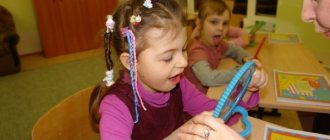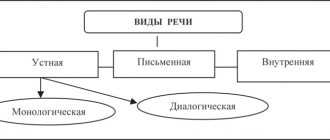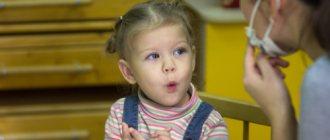The naked eye may not see the difference between children with mental retardation and signs of mental retardation.
In fact, their differences are fundamental. And, most importantly, this makes it possible for the first to further establish mental development and become a full-fledged unit of society with appropriate training. The latter, unfortunately, remain outside the game, excluding mental progress. However, there may be a third option, when a less exaggerated mental retardation (MD) worsens, acquiring the features of mental retardation (MR). To understand the mechanism of this transformation, it is necessary to clearly distinguish between both concepts.
Children with mental retardation
Mental retardation is a borderline state between normal and mental retardation, expressed in a slowdown in the rate of normal mental development of a given age period. Accompanied by a lag in the development of mental functions, such as thinking, memory, attention, emotions, and the volitional sphere. This is manifested in meager intellectual activity, limited knowledge and ideas, dominance of gaming interests, and rapid fatigue from intellectual work.
In other words, the child behaves infantilely. His behavior does not correspond to his real age. It seems to roll back, several steps lower, repeating the behavior of younger children.
However, under conditions of correct training, such a child is able to adapt quite well to life in society, increasing the level of his development.
Among the causes that provoke pathology, biological and social factors can be distinguished. Biological include pathologies during pregnancy, prematurity, birth injuries, genetic diseases, severe somatic diseases, injuries, infections at an early age, hearing and vision problems. Social factors include:
- pedagogical neglect;
- systematic psychological trauma;
- unacceptable conditions of upbringing;
- limited life activity of the child.
Interestingly, since 1997 the term “mental retardation” does not officially exist. With the introduction of ICD-10, this concept is included in the category of “mental developmental disorders”.
Depending on the cause, mental retardation can manifest itself in several forms.
The first form is constitutional in nature and occurs in children with an infantile body type. Such children show bright, lively emotions that prevail in behavior. Their development lags behind the age norm, corresponding to an earlier stage of development. They are completely involved in play activities, express themselves creatively, and are very active.
These are precisely those schoolchildren who find it difficult to sit in class and maintain discipline. Due to the reduced ability to control one’s behavior, thinking, and emotional-volitional sphere outside favorable conditions, this state of affairs can boil down to social maladjustment.
The 2nd form is of a somatogenic nature, that is, it occurs in connection with chronic diseases that cause loss of strength and decreased activity. This forms character traits such as lack of self-confidence, various kinds of fears, doubts, and timidity.
Overprotection in connection with illness further reinforces existing infantilism. The child is unable to concentrate and direct attention in the right direction. He is emotionally unstable, easily unbalanced, has low self-esteem and high anxiety.
The 3rd form develops as a result of pedagogical neglect. Such children are physically completely healthy and have an initially normal nervous system. In conditions of lack of information, education and emotional closeness with significant people, they have insufficient development of the necessary skills, abilities, and knowledge.
With this form of mental retardation, mosaic thinking predominates. This is a fragmentary perception, knowledge a little about everything, which is not supported by experience and experiences. So, children with form 3 mental retardation are very well oriented and smart in situations that are familiar to them or in things that arouse genuine interest. If a child develops in conditions of attention deficit, he acquires such traits as lack of control over his own emotions, impulsiveness, and irresponsibility.
Overprotection leads to egocentrism, lack of will, and parasitism. In general, a child has well-developed mental functions (memory, thinking, attention), but may not be able to read, count, or know basic geometric and mathematical concepts. However, imaginative thinking is highly developed.
The 4th form is caused by organic damage to the central nervous system during pregnancy, childbirth and during the first year of life. Immaturity and infantilism manifest themselves in all areas. Motor dysfunction is expressed in the form of increased excitability, clumsiness of movements, and sleep disturbances. Emotions are primitive, dim. The game is stereotypical and monotonous, but prevails over educational activities.
Such children are conventionally divided into two categories: with high mood (impulsiveness, disinhibition) and low mood (timidity, fears, lack of independence). The 4th form of mental retardation causes partial, that is, partial impairment of cognitive activity.
ZPR is not a total underdevelopment, but is expressed in a slowdown in the rate of mental development. It should be understood that the condition is reversible, but subject to proper specific training.
How to develop sound pronunciation and speech understanding
Formation of speech in children with mental retardation is a long process. To correct and encourage the development of phonemic hearing and sound pronunciation, not only a number of exercises are required, but also preparation for them.
An articulatory warm-up is done; breathing exercises and fine motor skills exercises (for example, finger exercises) are also recommended. Such games can be accompanied by fairy tales, pictures, poems, and music.
After charging comes the main block of exercises. To develop understanding of speech, exercises with cards are used. There are several options. For example, a child might pick up a card that shows a sound that was said. Or show a word that has the specified sound. You can suggest choosing pictures that begin with the same letter.
A useful exercise is a game in which participants take turns saying words, but so that the first letter of the word coincides with the last letter of the word of the previous participant.
To correct speech, it is necessary to visit a speech therapist, who will teach you how to pronounce sounds correctly, and not just identify them.
Mental retardation
This name was given to underdevelopment of mental activity. As a rule, it is provoked by several factors, among which genetic diseases come first. The other group consists of exogenous factors: trauma, intoxication, infection, fetal hypoxia.
Mental retardation is irreversible and is characterized by the following features:
- totality of the lesion - all neuropsychic functions are disrupted. Speech especially suffers - the grammatical side, the active vocabulary is very meager. Emotions are flat, monotonous, little controlled;
- Among mental processes, thinking is the first to suffer. Its deficiency leads to underdevelopment of elementary mental processes: memory, speech, perception.
UI is primarily represented by oligophrenia . This is underdevelopment of the brain associated with irreversible damage to the cerebral cortex. It is a congenital or acquired defect before the age of two.
There are three degrees of oligophrenia:
- debility;
- imbecility;
- idiocy.
They differ in the severity of the intellectual defect. If IQ with debility ranges from 50 to 70, then with idiocy this figure is 20.
Children suffering from debility are capable of simple work. They find it difficult to learn new skills, and their emotions are very primitive. Sensorimotor reactions are slowed. Phrase speech and mechanical memory are preserved. They are able to master basic reading, writing, and counting skills. Debility is the mildest degree of the disorder.
Imbecility preserves the most primitive self-service skills, the ability to remember a small amount of information, and allows one to acquire basic learning skills.
Idiocy is a gross, deep disturbance of thinking (virtually absent) and all mental processes in general. Such children are not capable of self-care and have poor spatial orientation. Almost no one recognizes them except the people caring for them. Behavior is often dictated by instinctive programs. The speech is incomprehensible. Expressions of emotions such as crying and tears are not typical.
Dementia is an acquired dementia that develops in a child after 2-3 years of age, and is accompanied by the collapse of already formed mental functions. Infections or injuries can trigger dementia. The condition is characterized by uneven damage, with some parts of the brain affected more than others.
conclusions
Don't ignore early signs that your child is having difficulty understanding or producing speech. Attention is paid not only to the correctness of sounds, but also to the logic of the narrative, speed and compliance of the level of speech with standards at a certain age.
Defects are easier to fix when they are not running. This is done both with the help of specialists and at home, because the process of learning and correction is a game and live communication. If you have patience and desire, every adult can work with a child.
Work should be based on games and regular repetition of even the smallest details. The process of cognition and learning should not end, because it is multi-stage. There will always be areas where you can improve or make the task more difficult. During classes, the child should feel comfortable, the material should arouse his interest, but not negative emotions.
Mental retardation and mental retardation: what is the difference
Both conditions are very similar to each other, since in both cases there is distortion, disruption of mental functions and a discrepancy between the child’s level of development and his age. That is, behavior, emotions, and intelligence are at a stage characteristic of a younger age. However, the specialist is obliged to conduct differential diagnostics in order to determine the diagnosis. This is very important, since mental retardation and mental retardation are subject to different methods of therapy, pursuing separate goals.
To quickly grasp the difference between disorders, let's present their comparison in the form of a table:
| Type of disorder characteristics | ZPR | UO |
| Character | Reversible | Irreversible |
| Type of violation | Slowing down the pace of mental development | Underdevelopment of the cerebral cortex, causing underdevelopment of mental functions |
| Scale | Partiality - partiality, some functions are better developed, others worse | Totality – almost all functions suffer |
| Primary defect | Partial damage to basal structures | Underdevelopment of the frontoparietal region of the brain tissue, causing insufficiency of higher mental activity |
| How it develops | From bottom to top: initially, elementary mental processes suffer: attention, memory, emotions, causing defects in mental activity. | From top to bottom: first of all, there is underdevelopment of thinking, which disrupts all other mental functions |
Play, the most important activity for children, with mental retardation is more emotional, but rather meager and limited, and it is difficult to imagine it figuratively. Children with delayed developmental skills typically get stuck in story-based play without reaching the role-playing stage. Children with ID become fixated on object-based play.
It should be noted that both disorders entail impairment of the intellectual, cognitive, and social spheres. But with ZPR, these violations are less threatening in nature and have the possibility of their further development under proper conditions. With mental retardation, unfortunately, there is no likelihood of progression of mental development. The formed defect, regardless of the degree, is persistent and unchanged.
Dementia, in contrast to mental retardation, entails the disintegration of personality, a total, gross disorder of activity with an almost complete shutdown of functions.
How does the ZPR transfer to the UO?
Defects in mental activity with a delay in mental retardation tend to transform both towards progress and towards regression. For example, there are cases where a child in an orphanage, as if in a frozen state, does not walk, does not talk, freezes at one point, being adopted by a prosperous family, literally in a week learns all the skills appropriate to his age. He is quickly gaining weight and improving his communication skills.
On the other hand, a slowdown in the rate of development can increase, exacerbating its manifestations. In addition, the term ZPR is applicable only for preschoolers and primary schoolchildren. If, after primary school age, signs of mental retardation persist, then it goes into the category of mental retardation.
The main role in the progression of symptoms of mental retardation is played by untimely or completely ignored measures to correct the condition. It is very important to begin corrective treatment for such children as early as possible. It requires special training. Regular schools cannot create the necessary conditions to accept such children. When time is lost, existing defects deepen on all fronts:
- Cognitive processes - attention, perception, memory - are further distorted, which inevitably leads to a decrease in intellectual activity;
- both written and oral speech do not progress. The child is not able to receive information from the outside in sufficient quantities, which is why he withdraws into himself. Communication ties with the world are severed. Establishing contact with peers and family members becomes almost impossible. Thus, the baby self-isolates and withdraws into himself;
- Due to the regression of cognitive abilities, it is difficult for children with advanced forms of mental retardation to master even basic skills. There is no natural age-related change in activity from play to learning;
- the emotional sphere is deteriorating. The child becomes labile and does not control his emotions.
Relationships with parents, in particular with the mother, play a special role. Feeling irritation, lack of support, and love on her part, kids turn into capricious, touchy and stubborn bullies, or fall into a stupor. The lack of emotional connection gives rise, in addition to personal degradation, to fears and anxiety.
In general, children lose touch with the world around them. In the future, it becomes difficult for them to adapt to the team, decide and get a profession, and establish interpersonal relationships. The advanced stage of mental retardation makes the child infantile, uncontrollable, distracted and helpless, and can lead to traits corresponding to mental retardation.








